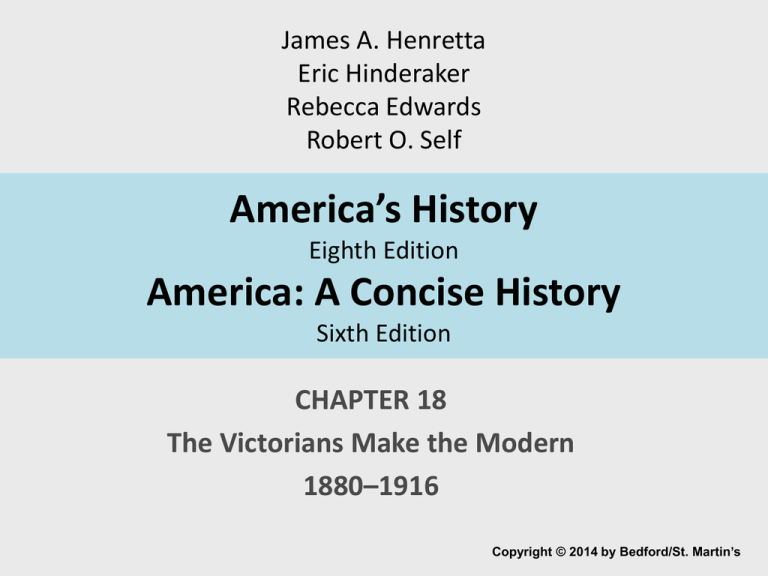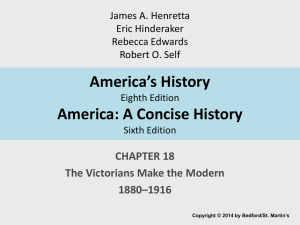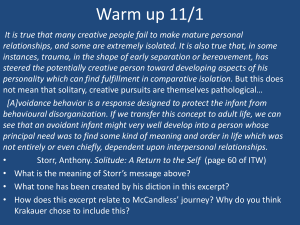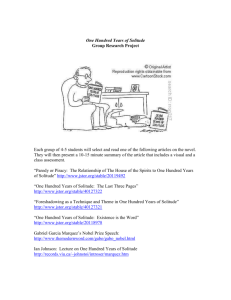America's History Seventh Edition
advertisement

James A. Henretta Eric Hinderaker Rebecca Edwards Robert O. Self America’s History Eighth Edition America: A Concise History Sixth Edition CHAPTER 18 The Victorians Make the Modern 1880–1916 Copyright © 2014 by Bedford/St. Martin’s I. Commerce and Culture A. Consumer Spaces 1. The circus -P. T. Barnum used rail system for traveling circus; emphasized female entertainers to draw women’s attendance; promised middle-class parents that circus help children develop. 2. First-class rail cars -fitted with carpets, upholstery, and woodwork; first-class “ladies’ cars” were opulent and soon became sites of struggle for racial equality; prohibited African Americans I. Commerce and Culture A. Consumer Spaces 1. The circus 2. First-class rail cars 3. Plessy v. Ferguson (1896) -Decision declared that “separate but equal” facilities for African Americans on railroad cars and in other public facilities did not violate the Fourteenth Amendment; securing approval on segregation, the Plessy decision allowed Jim Crow laws to stand and expand. I. Commerce and Culture B. Masculinity and the Rise of Sports 1. “Muscular Christianity” -(1851), YMCA was first promoter of physical fitness in the U.S. for young men; combined evangelism with gyms; 1900–1917 developed industrial program; serving on company teams instilled pride + teamwork; YMCA invented basketball and volleyball; should working class be participants? 2. America’s Game -Baseball, spread in popularity during Civil War, and became a professional sport after; National League launched in 1876; employers encouraged company teams. I. Commerce and Culture B. Masculinity and the Rise of Sports 1. “Muscular Christianity” 2. America’s Game 3. Rise of the Negro Leagues -At the turn of the century, most black players were barred from professional teams; development of segregated teams. 4. American Football -Grew out of Ivy League colleges in 1880s; Violent—6 player deaths in 1908; eventually, rules were put in place to protect players; professional teams developed in Pittsburgh, Green Bay (WI), and Chicago. I. Commerce and Culture C. The Great Outdoors 1. Preservation -National and state set aside land for preservation and recreation; extended the reach of national forests; Wilson created the National Parks Service (1916); Lacey Act (1900). Antiquities Act (1906) 2. Environmentalists -John Muir, an inventor from Wisconsin, founded the Sierra Club (1892) for exploring and preserving Pacific Coast; Audubon societies called for protection of bird species; new laws against hunting game caused controversy. II. Women, Men, and the Solitude of the Self A. Changes in Family Life 1. The average American family -Family size decreased in post-Civil War years; in 1800, 7 children average; in 1900, 3.6; farming families needed many children; families in industrial society concentrated their resources on helping the children succeed; couples married at older ages. Birth control. 2. Comstock Act (1873) -1873, Anthony Comstock secured a federal law banning “obscene materials” from U.S. mail; applied to any information about sex and birth control; supported by those who feared the rising sexual exposure made available by industrialization. II. Women, Men, and the Solitude of the Self B. Education 1. The rise of high school -by 1900, 71% of Americans between 5 and 18 attended school; curriculum included literature, composition, history, geography, biology, mathematics, ancient and modern languages, and athletics. 2. College -By 1920, approximately 8% of youth were attending public universities; state schools emphasized technical training while private colleges pioneered liberal arts. 3. African American education 4. Women’s education II. Women, Men, and the Solitude of the Self B. Education 1. The rise of high school 2. College 3. African American education -Tuskegee Institute (1881) established by Booker T. Washington; was a school for industrial education; focusing on training wage earners for economic success. 4. Women’s education -In the Northeast and South, women attended single-sex schools or teacher-training colleges; Vassar College (1861) gave an education equal to that of males;; Midwest and West offered public coeducational universities. II. Women, Men, and the Solitude of the Self C. From Domesticity to Women’s Rights 1. The Woman’s Christian Temperance Union -The Woman’s Christian Temperance Union (WCTU) -1874, led by Frances Willard; advocated prohibition of liquor; put women at the forefront of public reform; began national movement against domestic violence; founded soup kitchens and free libraries; investigated prisons; advocated for 8-hour workday and an end to child labor; called for woman suffrage; supported the Prohibition Party; 2. Women, Race, and Patriotism II. Women, Men, and the Solitude of the Self C. From Domesticity to Women’s Rights 2. Women, Race, and Patriotism -Daughters of the American Revolution (1890) excluded black women; -United Daughters of the Confederacy (1894) was founded to praise the South’s “Lost Cause”; -Ida B. Wells organized one-woman campaign against lynching (1892) but won little support; -National Association of Colored Women (1896) showed that black women shared with white women the determination to carry domesticity into the public sphere; -Women’s Convention of the National Baptist Church (1900) was the largest black women’s group. II. Women, Men, and the Solitude of the Self C. From Domesticity to Women’s Rights 3. Women’s Rights -Rival suffrage organizations reunited as the National American Woman Suffrage Association (NAWSA) in 1890. By 1913, most women living west of the Mississippi have the vote; antisuffragists organized National Association Opposed to Woman Suffrage (1911); by the 1910s, some women began to call for women’s full political, economic and social equality; Heterodoxy Club (1912) organized in NYC for intellectuals, journalists, and labor organizers who supported women’s rights and liberation (called themselves feminists). Beliefs of Anti-Suffragists • Women were high-strung, irrational, and emotional • Women were not smart or educated enough • Women should stay at home • Women were too physically frail; they would get tired just walking to the polling station • Women would become masculine if they voted 18 III. Science and Faith A. Darwinism and Its Critics 1. Theory -1859, On the Origin of Species, Darwin argued that all creatures struggle to survive, some are born with mutations making them more fit (“natural selection”) 2. Social Darwinism -theory developed by Herbert Spencer, British philosopher; William Graham Sumner claimed the wealthy were the “fittest”;; critics argued this was making excuses for the excesses of industrial society. III. Science and Faith A. Darwinism and Its Critics 1. Theory 2. Social Darwinism 3. Eugenics -Pseudo “science” that argued mentally deficient people should be prevented from reproducing; proposed sterilization laws; associated with “lower races,” which led to increased discrimination. III. Science and Faith B. Realism in the Arts 1. Naturalism -Suggested that human beings were victims of forces beyond their control (impulses and desires); Stephen Crane’s Maggie: A Girl of the Streets (1893); Jack London’s story, “The Law of Life” (1901); and Mark Twain’s A Connecticut Yankee in King Arthur’s Court (1889). 2. Modernism -Rejected traditional canons of literary taste; focused on subconscious and “primitive” mind; sought to overturn convention and tradition; questioned progress; Painters invented their own forms of realism; III. Science and Faith C. Religion: Diversity and Innovation 1. Immigrant Faiths -Connections to churches decreased because of harshness of industrial society; immigrant Catholics established parishes based on ethnicities (Irish, Italian, Polish); native-born American Jews embraced Reform Judaism. 2. Protestant Innovations -1916, Protestants still a majority in the U.S. Faced increasing political pressure from Catholics; Protestants worked to evangelize through “Social Gospel”: founded YMCAs, revealed faith through their public welfare and social justice efforts; introduction in U.S. of British Salvation Army. III. Science and Faith C. Religion: Diversity and Innovation 1. Immigrant Faiths 2. Protestant Innovations 3. Fundamentalists -Conservatives concerned about rising secularism; a series of Bible Conferences at Niagara Falls were held between 1876 and 1897; reaffirmed the literal “truth” of the Bible and certain damnation of those not born again in Christ; used revival meetings;






